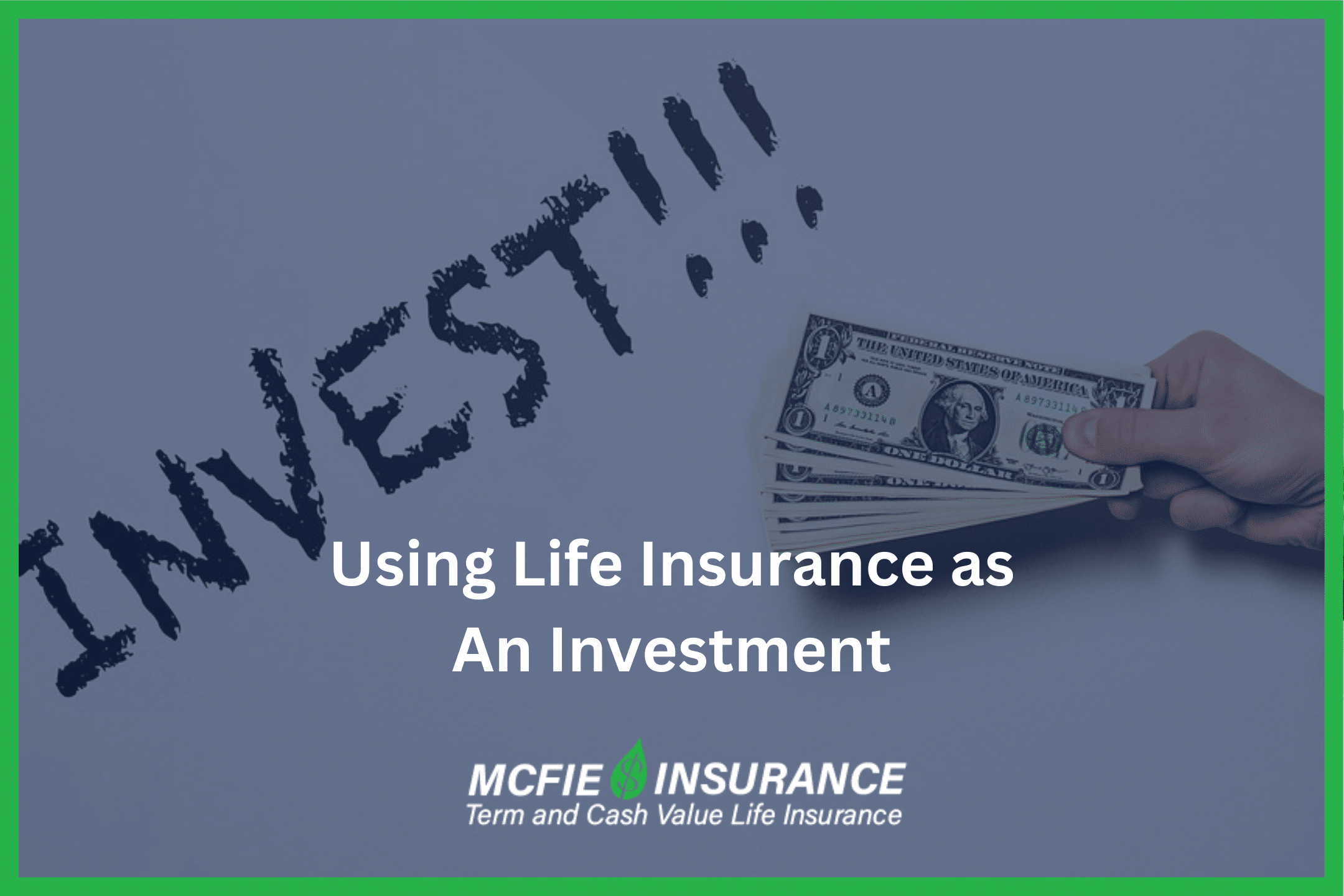317-912-1000
317-912-1000

Investing information provided on this page is for educational purposes only. McFie Insurance does not offer advisory or brokerage services and does not recommend or advise investors to buy or sell particular securities.
When it comes to planning your financial future, there are numerous routes available. Most people are familiar with traditional investments like stocks, bonds, and real estate, but one strategy which is often overlooked is using life insurance as a key part of your saving and investing process.
Life insurance is technically not an investment, but sometimes people think of it as an investment because the right type of policy can provide not only protection for your loved ones, but also serve as a powerful tool for building wealth and securing your financial future.
So, should you use life insurance as an investment? You be the judge. In this post we explore the concept of using life insurance as an investment, with a focus on participating whole life insurance (PWLI).
When you explore a new investment option, one of the first questions that comes to mind is likely: What is the expected rate of return?
When it comes to participating whole life insurance, you can’t find an annual rate of return because the insurance company guarantees a table of values, which includes year by year cash value and death benefit numbers, based on a specific schedule of premiums, a health rating and the insurance company’s current product offering.
There are guaranteed values on the left side, and non-guaranteed (aka projected) values on the right side of a typical life insurance illustration, but no annual rate of return.
When you dig deeper into the illustration, or the contract for a whole life insurance policy, you may find a rate of return that is assumed for the purpose of calculating guaranteed values, or a rate of return that is used to help define the current dividend scale, but these rates of return are simply the investment component of the insurance company’s returns before expenses and mortality are factored into the equation.
This means we must work from the values on the illustration. It is possible to figure a rate of return from a life insurance illustration by working backwards from the cash value for a specific year and the premium schedule up to and including the same year. This calculation is an iterative cut/try process that results in an Internal Rate of Return (IRR).
An IRR in this case, is the net rate of return (after fees and taxes) that you would have to earn every single year on an investment schedule matching premiums paid, in order to arrive at the cash value for the policy year in question. The same process can also be used to calculate an IRR for the death benefit values on a life insurance policy.
A whole life insurance policy designed for high cash value and minimal long-term insurance cost will usually have an IRR of about 1-2%/year based on guaranteed cash values during a 20-30yr time frame.
The IRR on non-guaranteed/projected cash values will often be in the 3-4% range for a similar time frame, but this is based on the profits of the insurance company and can easily be higher or lower than projected over a long period of time.
Obviously, there are investments that can potentially generate higher returns than these figures, but this does not mean you should skip the steady returns and the permanent life insurance coverage that come with a good whole life insurance policy. It is important to note that investment returns higher than this are not often consistent.
Due to these facts, many people like to think of their life insurance as an investment and count the cash values as a part of their investment portfolio, similar to bonds and/or cash in their overall asset allocation. Bonds can provide a steady return over time but can also be subject to interest rates and volatility if you need to sell them before maturity. Cash value growth in a participating whole life insurance policy is steady and guaranteed even when you need access via policy loans along the way.
Life insurance can be more than just a safety net; it can also be a valuable financial resource. Over time, as you contribute to your policy, you accumulate the option to borrow against the savings you’ve built up. Additionally, your earnings grow on a tax-deferred basis. Here are some ways to leverage the financial potential of your life insurance.
With permanent life insurance, you have the option to take a loan against its cash value. It’s important to understand the terms of this loan, including the interest rate, which may be fixed or variable and is determined by the insurance provider. Be aware that if the loan isn’t repaid by the time of your passing, any remaining debt will be deducted from what your beneficiaries receive.
In certain circumstances, your life insurance policy can act as collateral for a loan. This could potentially make it easier to secure a loan or negotiate better loan terms. It’s important to remember that if you pass away before the loan is repaid, the owed amount will be deducted from the benefits your heirs receive.
Instead of taking out a loan, you can opt to directly withdraw funds from your policy. However, if your withdrawal dips into your investment gains, tax implications may arise. Also, any amount withdrawn reduces the policy’s value and, consequently, the payout to beneficiaries upon your death.
Some policies offer the option to access benefits early in the event of a severe medical crisis, such as cancer or heart attack. These policies often allow withdrawals ranging from 25% to 100% of the policy’s value.
Surrendering your policy is essentially canceling your coverage in exchange for its cash value, minus any fees charged by the insurer. These fees can sometimes be substantial, akin to early withdrawal penalties from a retirement account. However, if your financial priorities shift and maintaining the policy is no longer feasible, surrendering it can be a practical choice.
Participating whole life insurance (PWLI) provides several benefits that can make it attractive from an investing perspective. Here are a few:
Participating whole life insurance operates on a simple principle. It’s kind of like buying a home on a mortgage. You pay regular premiums, which buy a death benefit (similar to the value of your home) and these payments also build a cash value which represents “equity” in your death benefit which grows over time.
Cash value in a whole life insurance policy represents the portion of your death benefit which no longer poses a risk to the insurance company. By age 100 or 121, depending on the policy, cash value must equal the death benefit.
Oftentimes early cash value growth is accelerated with a paid-up rider which buys a small amount of death benefit for life and provides a corresponding high proportion of “equity”/cash value. This is kind of like making an extra payment on your mortgage, so the equity builds faster.
As your policy grows and receives dividends, these dividends can further enhance the growth of your policy’s cash value, buying more paid-up insurance. This is usually the default dividend option in a whole life insurance contract.
Many people build cash values in PWLI with an eye toward future retirement. Unlike contributions to many retirement accounts, where access is limited until age 59 1/2, life insurance cash values can be accessed via policy loan for self-financing all kinds of major purchases along the way.
This strategy can help people put more away toward a future retirement than they would feel comfortable locking in various tax-qualified plans.
Building cash value in life insurance before retirement can also provide more options to limit your taxable income when you get to retirement. You may be able to stay in a lower tax bracket by getting some of your income through non-taxable life insurance withdrawals and/or policy loans instead of having to draw so much from a qualified plan where the income is taxable. This is another area where it makes sense to think of whole life insurance as an investment.
A permanent death benefit can also be repurposed in retirement to help with estate planning or in rolling some of your assets to an annuity that may provide a higher guaranteed income. A life insurance death benefit can help to cover the risk that you might die earlier than you expect, before collecting the income you hope to collect from an annuity. This helps to ensure your family won’t lose money.
Finally, a permanent life insurance death benefit can help you to leave a legacy for your family, which many people want to do but would find hard without utilizing life insurance.
Here are some features of participating whole life insurance that are attractive from a tax perspective:
Note: A life insurance death benefit is included in your estate for estate tax purposes, but most people don’t pay estate taxes because of current high exemption amounts. If your estate is large enough to be taxable, life insurance is often an important part of estate planning and ensuring sufficient liquidity to pay estate taxes.
As with any financial decision, it’s important to evaluate the pros/cons associated with buying a participating whole life insurance policy. Whole life insurance offers stability, tax advantages, potential growth, and it can be a great wealth building tool.
It’s also important to consider how buying a new policy aligns with your other financial goals.
This is where we can help at McFie Insurance. We like to talk with each of our clients, understand your situation and make sure we design a policy for you that will align with your goals in a great way. You can reach us by calling: 702-660-7000.
If you’re interested in including participating whole life insurance as part of your investment strategy, here are a few key points to consider:
Using life insurance as part of your investment strategy, particularly participating whole life insurance, offers a range of benefits across a wide spectrum of ages and financial strategies.
By combining life insurance protection with a steady long-term growth potential, PWLI can serve as a versatile tool for building wealth. It’s always important to carefully evaluate your goals and work with ethical professionals to ensure a financial strategy, including life insurance, aligns with your individual needs.
Using participating whole life insurance as a financial tool can help to secure your financial future and provide more options in a way that is more stable than just relying upon a conventional portfolio of stocks/bonds.
 by John T. McFie
by John T. McFie
I am a licensed life insurance agent, and co-host of the WealthTalks podcast.
As a 15-year practitioner of the Infinite Banking Concept on a personal level, I can help you find the clarity and peace of mind about your financial strategy that you deserve.
Working with hundreds of financial scenarios over the years has helped me to develop a sixth sense about how to quickly find a clear and balanced solution for clients using whole life insurance as a financial tool.